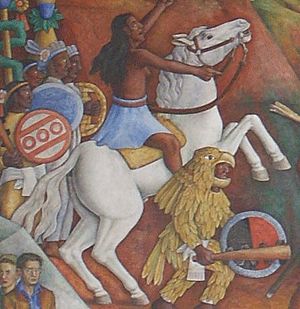Princess Eréndira facts for kids
Quick facts for kids Eréndira |
|
|---|---|

Princess Eréndira on horseback, painted by Juan O'Gorman.
|
|
| Reign | 1503-1529 |
Princess Eréndira of the Purépecha was a brave princess from the Purépecha people who lived from about 1503 to 1529. Her story is a legend about her fight against the Spanish invaders in Mexico.
Eréndira's Life and Resistance
Eréndira was around 16 or 17 years old when the Spanish arrived in Mexico. At that time, the ruler of the Purépecha Empire, named Tangaxuan II, had decided to give up his kingdom to the Spanish. He did this after seeing how easily the Aztec Empire had fallen to the Spanish forces.
The story of Princess Eréndira as a hero is based on old traditions and legends. It's important to know that there are no official records from that time that prove she existed. However, her story is still very important to the Purépecha people.
According to the legend, Eréndira held a special ceremony for Charatanga, the moon goddess. The next day, a Spanish warrior named Cristóbal de Olid came to Tzintzuntzan with many soldiers.
Eréndira had promised a Purépecha man named Nanuma that they would marry if he won the battle. Nanuma led his people into the fight. But he became scared of the Spanish weapons and horses and tried to run away. Cristobal de Olid captured him. Without their leader, the Purépecha warriors were quickly defeated.
Cristobal de Olid punished Nanuma by making him and his men serve food to the Spanish army. To capture Eréndira's father, Tangaxuan, Cristobal de Olid forced the Purépecha warriors to fight against their own people. Nanuma led them, hoping to get Eréndira if he cooperated.
Eréndira gathered the people of Tzintzuntzan and attacked the Spanish army from a hill. They defeated Nanuma and his warriors, and Nanuma ran away again. Eréndira's army captured a white Spanish horse. They planned to sacrifice it, but Eréndira asked to keep it. She tamed the horse, and they became very close. She even let the horse sleep in her home!
After some time of peace, Nanuma returned to surprise Tzintzuntan. He planned to take Eréndira as a slave if she didn't marry him. Eréndira escaped on her horse and rode away.
With Eréndira gone, her father, the ruler, became a Catholic. He invited a priest named Fray Martin to the city. Fray Martin destroyed the statues of the Purépecha gods. He converted many Purépecha people to Christianity. However, he suspected that Tangaxuan was still secretly following his old religion. Because of this, a Spanish warrior named Nuño de Guzmán had Tangaxuan killed.
When Eréndira learned that her father had been killed, she used her horse to start a secret resistance movement against the Spanish.
There are different ideas about what happened to Eréndira. Some stories say she drowned. Others say she left to train more people for war. One legend even claims her own people hid her in a temple so the Spanish couldn't find and kill her.
Eréndira's Importance Today
Eréndira became a very important symbol of native resistance against the Spanish conquest. She is often seen as the opposite of Malinche, another indigenous woman who helped the Spanish.
When Lázaro Cárdenas was the governor of Michoacán, he built a house in Pátzcuaro and named it "La Quinta Eréndira." As governor and later president, Cárdenas helped make Eréndira's story known to many more people. He wanted to highlight the history of the native people of Michoacán, not just the Aztecs.
Artists were asked to paint murals showing Purépecha history. Eréndira's story helped shape the idea that the Purépecha past was an important part of Mexico's beginnings.
In Popular Culture
The movie Erendira Ikikunari (which means Erendira the Untameable) is based on the story of Princess Eréndira.
See also
 In Spanish: Eréndira para niños
In Spanish: Eréndira para niños

